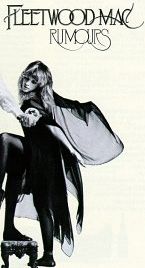 Record
sleeves, either big old 12inch squares or their five inch CD offspring, we
love Ćem, don't we? Who hasn't rushed home from their local record emporium
with a brand new piece of vinyl, stuck it on the turntable and spent the next
couple of hours pouring over the sleeve; taking in every detail of the cover,
reading the lyrics to each track as it plays and studying the credits - the
producer, the photographer, the stylist for Stevie Nicks' hair - all
the important stuff!
Record
sleeves, either big old 12inch squares or their five inch CD offspring, we
love Ćem, don't we? Who hasn't rushed home from their local record emporium
with a brand new piece of vinyl, stuck it on the turntable and spent the next
couple of hours pouring over the sleeve; taking in every detail of the cover,
reading the lyrics to each track as it plays and studying the credits - the
producer, the photographer, the stylist for Stevie Nicks' hair - all
the important stuff!
So just how important to a piece of recorded music is the sleeve design itself and does it have any bearing on whether or not you buy the product?.
From a marketing point of view, of course, the sleeve is vital. It needs to communicate a large amount of information - the name of the artist and the title of the album for starters - and if possible it should give you a visual feel of the type of music contained within the cover, as well as all the necessary legal info. (usually confined to 6 point type on the bottom of the back cover), and all in a clear and attractive way. It also needs to stand out in the racks - it's going to be up against some pretty stiff opposition out there, and it won't always have any promotional material (if any, depending on the record company budget), to back it up.
On the other hand, it is patently obvious to me that it is the content that sells a record or CD - if the music is no good, then you are not going to buy it, no matter how good the sleeve! I can't think of a single instance where the sleeve alone has 'forced' me to listen to the music inside. Most punters have a built-in brand (or in this case 'band') loyalty; we like a particular artist and are more inclined to buy their work irrespective of the packaging, although we appreciate it if the design is good; there is nothing worse than trying to convince your mates of an albums worth, if it comes clothed in the most embarassingly bad sleeve ever designed! Every release deserves a piece of good design wrapped around it - it's an integral part of the overall package that the buyer is parting with their hard-earned cash to own.
Take 'Dark Side of the Moon' for example. It's a striking graphic, simple
but very, very
 effective
and has become an iconic image, thanks to the incredible success of the album.
But what if the design studio Hipgnosis had suggested it for another band -
perhaps a release by Vinegar Joe or Greenslade? I doubt it would have
increased their record sales by much and the old prism may not have become the
instantly recognisable image it is today. You could have stuck a picture of
a cow in a field on the cover and that record would still have sold in
millions... erm no, actually they couldn't, Floyd had already used that idea!
effective
and has become an iconic image, thanks to the incredible success of the album.
But what if the design studio Hipgnosis had suggested it for another band -
perhaps a release by Vinegar Joe or Greenslade? I doubt it would have
increased their record sales by much and the old prism may not have become the
instantly recognisable image it is today. You could have stuck a picture of
a cow in a field on the cover and that record would still have sold in
millions... erm no, actually they couldn't, Floyd had already used that idea!
 I have
been fortunate to have worked on a few album sleeves in my time (graphic
design is what I do for a day job), but they were all done in a world before
the Apple Mac - mechanical paste-up in a haze of spray mount and galley pulls;
where if you made a type error, single characters had to be cut out and
corrected individually - and images were exactly as they appeared in the
camera lens, with no retouching or photoshop trickery to be found. The Mac is
great and I wouldn't swap it for my old drawing board; but it's just a
different tool, of course - the creative thinking is still much the same - and
artwork is a hell of a lot easier. Mind you, my experience was at the lower
end of the record industry scale, working for a small independent folk label
where the crucial part of the creative process was the limited budget!
I have
been fortunate to have worked on a few album sleeves in my time (graphic
design is what I do for a day job), but they were all done in a world before
the Apple Mac - mechanical paste-up in a haze of spray mount and galley pulls;
where if you made a type error, single characters had to be cut out and
corrected individually - and images were exactly as they appeared in the
camera lens, with no retouching or photoshop trickery to be found. The Mac is
great and I wouldn't swap it for my old drawing board; but it's just a
different tool, of course - the creative thinking is still much the same - and
artwork is a hell of a lot easier. Mind you, my experience was at the lower
end of the record industry scale, working for a small independent folk label
where the crucial part of the creative process was the limited budget!
 Finally,
as a tenuous link to Lindsfarne, back in June 1983 and armed with a handful of
my folk sleeves, I managed to get interviews with three record labels, Sonet,
Rocket and Charisma, all on the same day. I was after some extra freelance
work with a music industry bias, but while the whole day was great fun, with
hindsight I didn't stand a hope in hell! My meeting at Charisma was the second
of the three at one of their offices in Wardour Street and although I really
wanted to meet 'Strat' (Tony Stratton-Smith), I ended up seeing their creative
director Peter Jenner, who I now know to be a founder of Blackhill Enterprises
back in the sixties and an early manager of Pink Floyd. He was very kind
towards my limited portfolio and actually said "well, I can see you know how
to work within a budget!" Later that day, the lady at Rocket Records was a
little more blunt but looking back, her criticism was valid and probably far
more useful to me at that point in time.
Finally,
as a tenuous link to Lindsfarne, back in June 1983 and armed with a handful of
my folk sleeves, I managed to get interviews with three record labels, Sonet,
Rocket and Charisma, all on the same day. I was after some extra freelance
work with a music industry bias, but while the whole day was great fun, with
hindsight I didn't stand a hope in hell! My meeting at Charisma was the second
of the three at one of their offices in Wardour Street and although I really
wanted to meet 'Strat' (Tony Stratton-Smith), I ended up seeing their creative
director Peter Jenner, who I now know to be a founder of Blackhill Enterprises
back in the sixties and an early manager of Pink Floyd. He was very kind
towards my limited portfolio and actually said "well, I can see you know how
to work within a budget!" Later that day, the lady at Rocket Records was a
little more blunt but looking back, her criticism was valid and probably far
more useful to me at that point in time.
However, Joe Stead and his Greenwich Village label continued to use me and
I got to work on sleeves for Pete Seeger, Martyn Wyndham-Read, Johnny Silvo
and the Wilson Family (who have probably never forgiven me for spelling
Teesside with only one 's') - that'll teach them to use a southerner!
Chris Groom